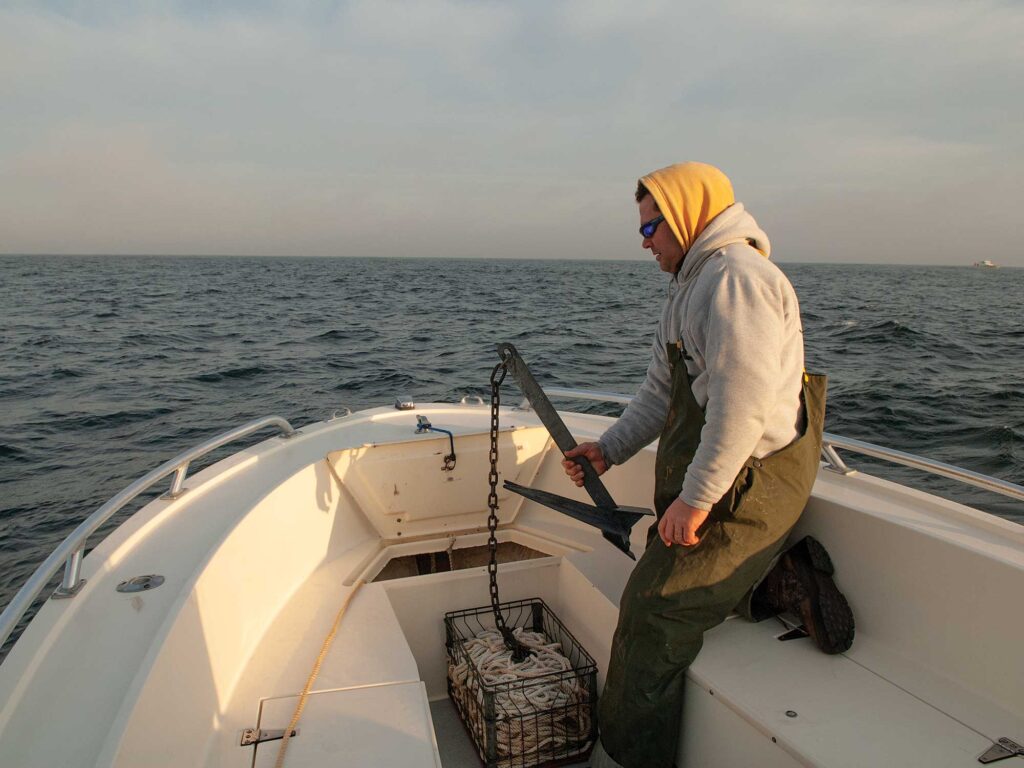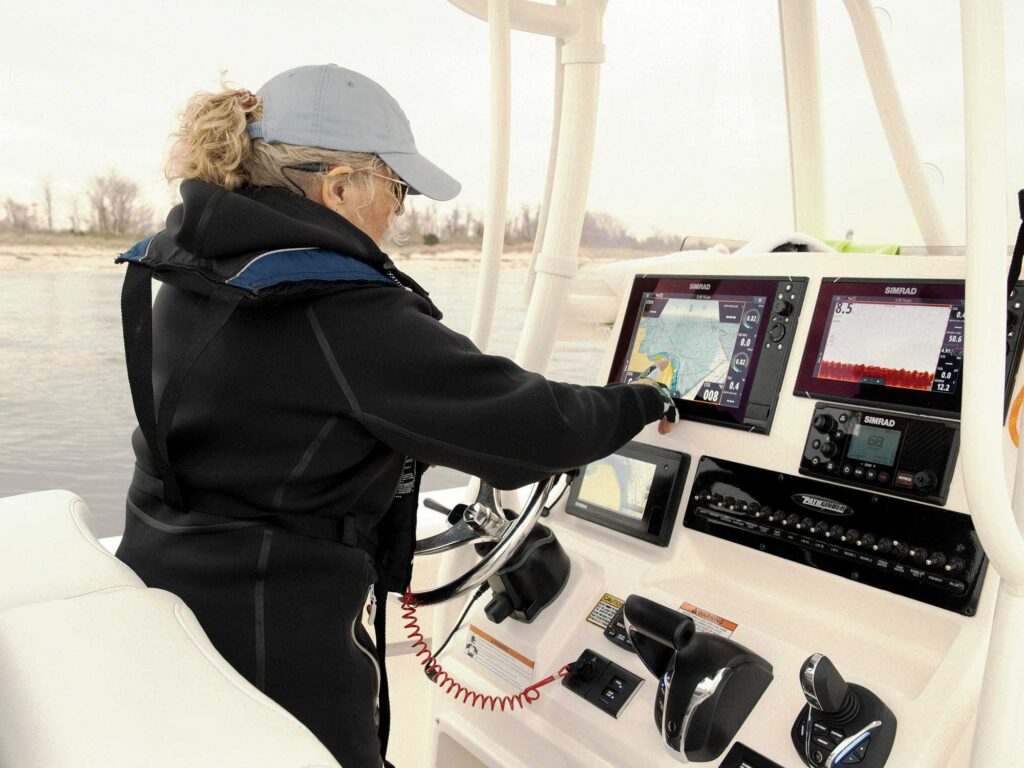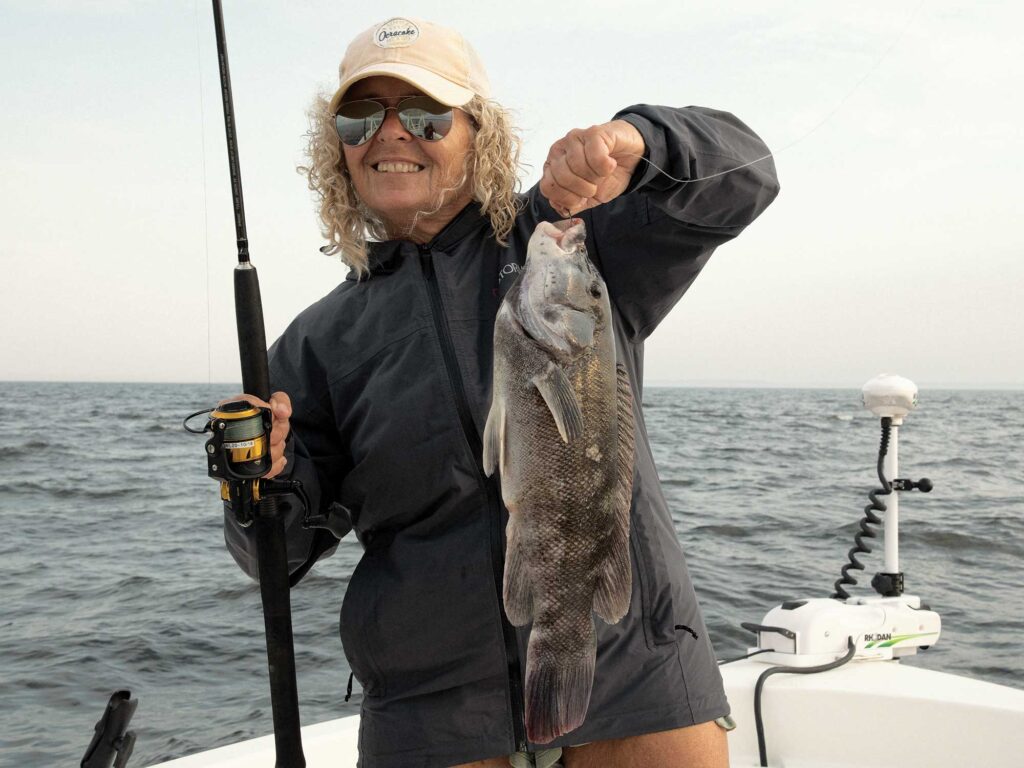Conventional vs. Virtual Anchoring
 Precision anchoring over a wreck to fish for tautog in Northeast waters has traditionally meant two sets of ground tackle with anchors set at 90 degrees to each other to prevent the boat from swinging.
Gary Caputi
Precision anchoring over a wreck to fish for tautog in Northeast waters has traditionally meant two sets of ground tackle with anchors set at 90 degrees to each other to prevent the boat from swinging.
Gary Caputi
Structure fishing, like buying real estate, comes down to three words: location, location, location. Getting on target can mean the difference between fish in the box or just unused ice. Today we have choices, from conventional anchoring with ground tackle to the latest in virtual anchoring.
Thousands of mid-Atlantic anglers share my affinity with catching tautog, aka blackfish. That is the species that prompted me to learn the art of anchoring for accuracy. In fact, I wrote a feature for Salt Water Sportsman with that title two decades ago. Tog fishing success typically comes with positioning your boat over a wreck, rock pile or mussel bed, then fine-tuning your location as you fish. It requires using a chart plotter and ground tackle (anchor, chain and line). The same goes for dozens of bottom species, from cod in New England to red snapper in the Gulf of Mexico.
Old-School AnchoringMany of the best structure spots are small, often indistinct. Using two conventional anchors is one of the most effective ways to get on top of them. I rigged my old 23-foot center-console with two sets of ground tackle, each consisting of a Danforth-style anchor, a 15-foot length of chain, and 600 feet of 3/8-inch nylon line. One set remained on the boat in the anchor locker, and the second fit neatly into a milk crate for storage off the boat when not in use. The key to double anchoring is positioning the two anchors about 90 degrees apart so once the boat settles back on both, you can fine-tune the position of the boat by playing one against the other.
Here’s the procedure. With the spot saved as a waypoint on the chart plotter, put the boat on it, and with the engine in neutral, allow it to drift with the prevailing wind and current for a few minutes to create a track line on the screen. To determine how far away from your waypoint to drop the anchors so they will have enough scope to set, the rule of thumb is to multiply water depth by a factor of 7. For example, if you’re in 50 feet of water, that would mean the anchors should be a minimum of 350 feet away from the waypoint. I used anchors one size larger than recommended for the boat to guarantee a quick set and be able to use less scope if necessary.
Picture a clock face on the plotter with your waypoint at 6 and the drift line pointing at 12. Place two temporary waypoints at 2 and 10 on the dial at the approximate distance from your initial waypoint for the anchors to set and hold. Run the boat a little past the first drop point, lower the anchor until it hits bottom, and slowly power back until the anchor bites. Then with the rode from the first anchor looped around the spring-line cleat on the same side of the boat, repeat the process with the second anchor. With both anchors holding, slowly power back, paying out rode until the boat comes to rest over your waypoint. Cleat them off at the bow and let the boat settle. Then you can move the boat by adjusting the anchor lines. To move to either side, let out line on one rode and pull in on the other. To adjust forward or back, let out or pull in on both lines. If the wind and current change significantly or you want to move more than is possible by adjusting the anchor lines, it’s time to pull one or both anchors and reset them. Double anchoring is a skill. It’s time-consuming and physical work, but if that’s all you’ve got, grin and bear it, and hope you are on the money with your choice of spots. The catching is worth the effort.
 Understanding how to use the chart function on your MFD proves essential to finding, anchoring on and fishing wrecks and reefs. Some trolling motors can also be controlled with a compatible MFD.
Gary Caputi
Virtual Anchoring
Understanding how to use the chart function on your MFD proves essential to finding, anchoring on and fishing wrecks and reefs. Some trolling motors can also be controlled with a compatible MFD.
Gary Caputi
Virtual Anchoring
I made the move to virtual anchoring with the purchase of a Pathfinder 2700 Open. I ordered it with the optional Rhodan 120-pound-thrust trolling motor and the Yamaha Helm Master EX digital helm system linked to a Yamaha F300 fly-by-wire outboard.
The first electric trolling motor was invented in 1934, and the first bow-mount type followed 30 years later, but it wasn’t until manufacturers added a GPS receiver to saltwater high-thrust models that their popularity exploded for ocean fishing. With GPS, a wireless remote, and software that enables automatic position holding, bottomfishermen found a new friend. Some manufacturers call it anchor mode, Minn Kota calls it Spot Lock, but by any other name, it’s high-tech magic.
Simply put the boat on your waypoint, deploy the trolling motor, hit the anchor button on the remote, and the software takes over controlling steering and speed to keep the bow of the boat planted on the numbers. While in anchor mode, you can move the boat in any direction incrementally with the remote with arrows corresponding to forward, back, right or left. Hit one of the buttons, and the motor will run in that direction and hold on the new position. To move farther, hit the button multiple times and away you go. Prospecting a piece of structure has never been easier.
With 36-volt models that can put out 120 pounds of thrust, trolling motors can handle surprisingly large boats. I fished a friend’s 35-foot Contender, and his motor held position effectively even in a stiff wind and strong current.
Read Next: New Electric Trolling Motors for Salt Water
Automatic Station-KeepingThe big surprise for me was the versatility of the Yamaha Helm Master EX system, an outboard-centric system that also incorporates virtual anchoring. It integrates digital electric steering, shift and throttle control, joystick and autopilot with the system’s proprietary GPS receiver and heading sensor, and can be linked to any brand of chart plotter for navigating. All those components feed data to an advanced computer system with AI-type software that can sense and respond to sea conditions while performing a long list of fishing functions, starting with the ability to accurately maintain the boat’s GPS position. With Helm Master for a single outboard, the function is called FishPoint; on multi-outboard installations, it is called StayPoint.
Here’s how it works. First activate the joystick, then hit the StayPoint button. You can set it to maintain position either bow or stern into the prevailing wind and current. The first time I used it I was amazed at how well it worked, as were anglers in nearby boats, who were trying to figure out how my boat was holding position without an anchor or trolling motor in the water. The engine was gently and quietly bumping in and out of gear and steering itself as I fished. I prefer to use it when fishing water deeper than 50 feet only because I worry about the potential of scaring wary fish with the big engine running in shallower water. In shallower waters, I use the trolling motor. While there are limitations to how deep you can effectively use conventional anchors—remember that 7-to-1 rule—there are no depth limitations when fishing with virtual anchoring systems; you can even use them when deep-dropping.
 The virtual anchoring functions in today’s powerful saltwater trolling motors enable anglers to position and hold boats over wrecks and other structure with amazing precision and great results.
Gary Caputi
More Auto Functions
The virtual anchoring functions in today’s powerful saltwater trolling motors enable anglers to position and hold boats over wrecks and other structure with amazing precision and great results.
Gary Caputi
More Auto Functions
Helm Master EX does a lot more than hold position. It is an amazing tool for trolling at any speed. Its Speed Control function works like the cruise control on a car, but it is capable of running the boat at speeds slower than idle with a function called Pattern Shift. The computer bumps the engine in and out of gear as needed to maintain slow forward motion down to less than 1 mph. When using it with the autopilot, you can troll hands-free. For drift-fishing or flying kites, the system has tricks that will make both techniques easier to control and fish more effectively.
The digital age of fishing is upon us and in a big way. I still have a conventional anchor on my boat, but only because it is a safety feature should the boat lose power. As for using it for bottomfishing, it’s no longer a consideration. If you are still anchor-bound, the lesson in double anchoring should be helpful. But once you experience bottomfishing with a virtual anchoring system, I guarantee that you’ll want to upgrade your ride.
The post Conventional vs. Virtual Anchoring appeared first on Salt Water Sportsman.
- Home
- About Us
- Write For Us / Submit Content
- Advertising And Affiliates
- Feeds And Syndication
- Contact Us
- Login
- Privacy
All Rights Reserved. Copyright , Central Coast Communications, Inc.